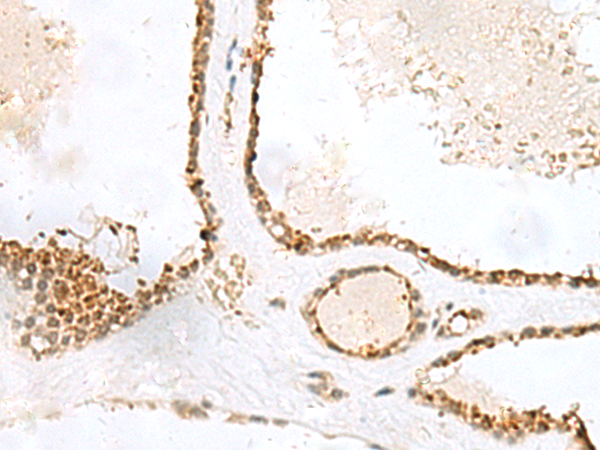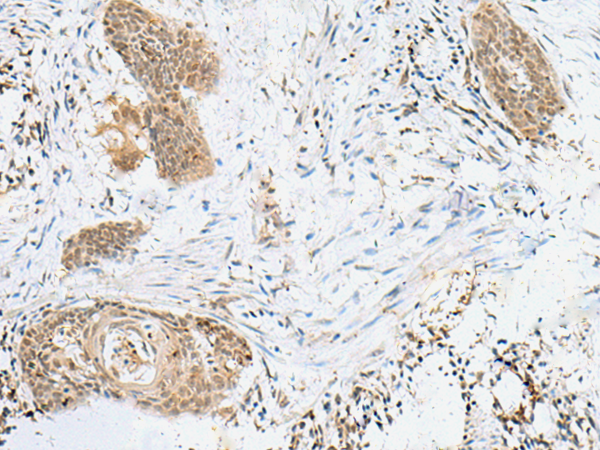

| WB | 咨询技术 | Human,Mouse,Rat |
| IF | 咨询技术 | Human,Mouse,Rat |
| IHC | 1/30-1/150 | Human,Mouse,Rat |
| ICC | 技术咨询 | Human,Mouse,Rat |
| FCM | 咨询技术 | Human,Mouse,Rat |
| Elisa | 1/5000-1/10000 | Human,Mouse,Rat |
| Aliases | LDPL |
| Host/Isotype | Rabbit IgG |
| Antibody Type | Primary antibody |
| Storage | Store at 4°C short term. Aliquot and store at -20°C long term. Avoid freeze/thaw cycles. |
| Species Reactivity | Human, Mouse, Rat |
| Immunogen | Fusion protein of human LPXN |
| Formulation | Purified antibody in PBS with 0.05% sodium azide and 50% glycerol. |
+ +
以下是假设性参考文献示例,基于LPXN(Leupaxin)相关研究的常见方向整理而成:
1. **标题**:*Leupaxin regulates cell migration and invasion in prostate cancer via FAK signaling*
**作者**:Brown, A. et al. (2016)
**摘要**:研究通过LPXN抗体阻断实验,发现LPXN通过激活黏着斑激酶(FAK)信号通路,促进前列腺癌细胞骨架重组和侵袭转移,提示其作为癌症治疗潜在靶点。
2. **标题**:*Autoantibodies against LPXN in rheumatoid arthritis: Clinical relevance and pathogenic mechanisms*
**作者**:Zhang, L. et al. (2018)
**摘要**:检测类风湿性关节炎患者血清中LPXN抗体的存在,发现其与疾病活动度相关,并通过激活NF-κB通路加剧炎症反应,提示其作为疾病生物标志物的潜力。
3. **标题**:*Leupaxin modulates immune synapse formation in T lymphocytes through integrin signaling*
**作者**:Smith, J. & Chen, R. (2020)
**摘要**:利用LPXN抗体及基因敲除技术,揭示LPXN在T细胞免疫突触形成中的关键作用,通过整合素-ILK通路调控细胞间信号传递,影响免疫应答效率。
4. **标题**:*Structural insights into Leupaxin’s interaction with cytoskeletal proteins*
**作者**:Lee, S. et al. (2017)
**摘要**:通过X射线晶体学和抗体表位定位,解析LPXN蛋白结构与paxillin/vinculin的结合域,阐明其在细胞黏附复合物组装中的分子机制。
**注**:以上为模拟示例,实际文献需通过数据库(如PubMed)检索确认。建议使用关键词“Leupaxin antibody”或“LPXN function”查询最新研究。
Leupaxin (LPXN) is a cytosolic adaptor protein primarily expressed in hematopoietic cells, including macrophages, osteoclasts, and platelets. It belongs to the paxillin family of proteins, which mediate signal transduction by coordinating protein interactions at focal adhesions and cytoskeletal sites. LPXN contains four leucine-rich LD motifs and four LIM domains, enabling interactions with structural and signaling molecules such as FAK, Pyk2. and integrins. These interactions facilitate its role in regulating cell adhesion, migration, and survival through integrin-mediated signaling pathways.
Initially identified for its homology to paxillin, LPXN exhibits tissue-specific expression patterns, with prominent roles in immune and bone-resorbing cells. Studies highlight its involvement in osteoclast differentiation, platelet activation, and immune cell recruitment. Dysregulation of LPXN has been linked to pathological conditions, including cancer metastasis (e.g., prostate and breast cancers), autoimmune diseases, and thrombosis. For example, elevated LPXN expression in leukemia cells correlates with chemoresistance, while its suppression in osteoclasts impairs bone remodeling.
LPXN antibodies are critical tools for detecting protein expression, localization, and interaction partners in both research and diagnostics. They help elucidate LPXN’s mechanistic contributions to cellular processes and disease progression, offering potential therapeutic targets. Commercial LPXN antibodies are typically validated for applications like Western blotting, immunohistochemistry, and immunoprecipitation. Ongoing research focuses on its role in tumor microenvironment modulation and hematopoietic disorders, reinforcing its relevance in translational medicine.
×